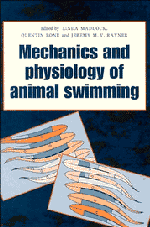Book contents
- Frontmatter
- Contents
- Contributors
- Introduction
- 1 Functional patterns of swimming bacteria
- 2 Buoyancy and swimming in marine planktonic protists
- 3 The role of fins in the competition between squid and fish
- 4 The biology of fish swimming
- 5 Swimming physiology of pelagic fishes
- 6 The mechanical design of the fish muscular system
- 7 How do fish use their myotomal muscle to swim? In vitro simulations of in vivo activity patterns
- 8 The timing of lateral muscle strain and EMG activity in different species of steadily swimming fish
- 9 Swimming in the lamprey: modelling the neural pattern generation, the body dynamics and the fluid mechanics
- 10 Swimming capabilities of Mesozoic marine reptiles: a review
- 11 Stone, bone or blubber? Buoyancy control strategies in aquatic tetrapods
- 12 Functional anatomy of the ‘flight’ apparatus in penguins
- 13 Energy conservation by formation swimming: metabolic evidence from ducklings
- Bibliography
- Index
8 - The timing of lateral muscle strain and EMG activity in different species of steadily swimming fish
Published online by Cambridge University Press: 05 March 2012
- Frontmatter
- Contents
- Contributors
- Introduction
- 1 Functional patterns of swimming bacteria
- 2 Buoyancy and swimming in marine planktonic protists
- 3 The role of fins in the competition between squid and fish
- 4 The biology of fish swimming
- 5 Swimming physiology of pelagic fishes
- 6 The mechanical design of the fish muscular system
- 7 How do fish use their myotomal muscle to swim? In vitro simulations of in vivo activity patterns
- 8 The timing of lateral muscle strain and EMG activity in different species of steadily swimming fish
- 9 Swimming in the lamprey: modelling the neural pattern generation, the body dynamics and the fluid mechanics
- 10 Swimming capabilities of Mesozoic marine reptiles: a review
- 11 Stone, bone or blubber? Buoyancy control strategies in aquatic tetrapods
- 12 Functional anatomy of the ‘flight’ apparatus in penguins
- 13 Energy conservation by formation swimming: metabolic evidence from ducklings
- Bibliography
- Index
Summary
Waves of electrical activity, measured as electromyograms (EMGs), running head to tail through the myotomes of the lateral swimming muscle are a common feature of forward steady speed swimming of fish. The detail of the EMG-onset and EMG-end timing has recently been shown to be of great significance when related to the strain (length change) cycle of the myotomal muscle fibres. The strain cycle is caused by the waves of curvature which pass along the body at a slower speed than the EMG waves during steady speed swimming. Based on this recent model, studies of seven fish species with and without tail blades are compared, and differences are indicated in the ways the myotomal muscle is used in different swimming modes.
INTRODUCTION
Historical overview
Pettigrew (1873) studied a swimming sturgeon and showed that at any given time the body simultaneously showed lateral bending to the left and the right giving it an ‘S’ shape. The dynamic character of fish swimming movements became apparent once recorded by cine film techniques, and Housay (1912) was the first to describe how a wave of curvature runs from head to tail in elongated fish.
We are now aware that the waves of curvature running along the body of steadily swimming fish are the result of the combined effect of the activity patterns generated in the myotomes, and the interaction between the fish's body and reactive forces from the water in which the fish moves. This implies that the coupling between the waves of muscle activity and the waves of curvature depend on the details of the body and fin shapes, which are a characteristic of each fish species.
- Type
- Chapter
- Information
- The Mechanics and Physiology of Animal Swimming , pp. 111 - 118Publisher: Cambridge University PressPrint publication year: 1994
- 6
- Cited by

